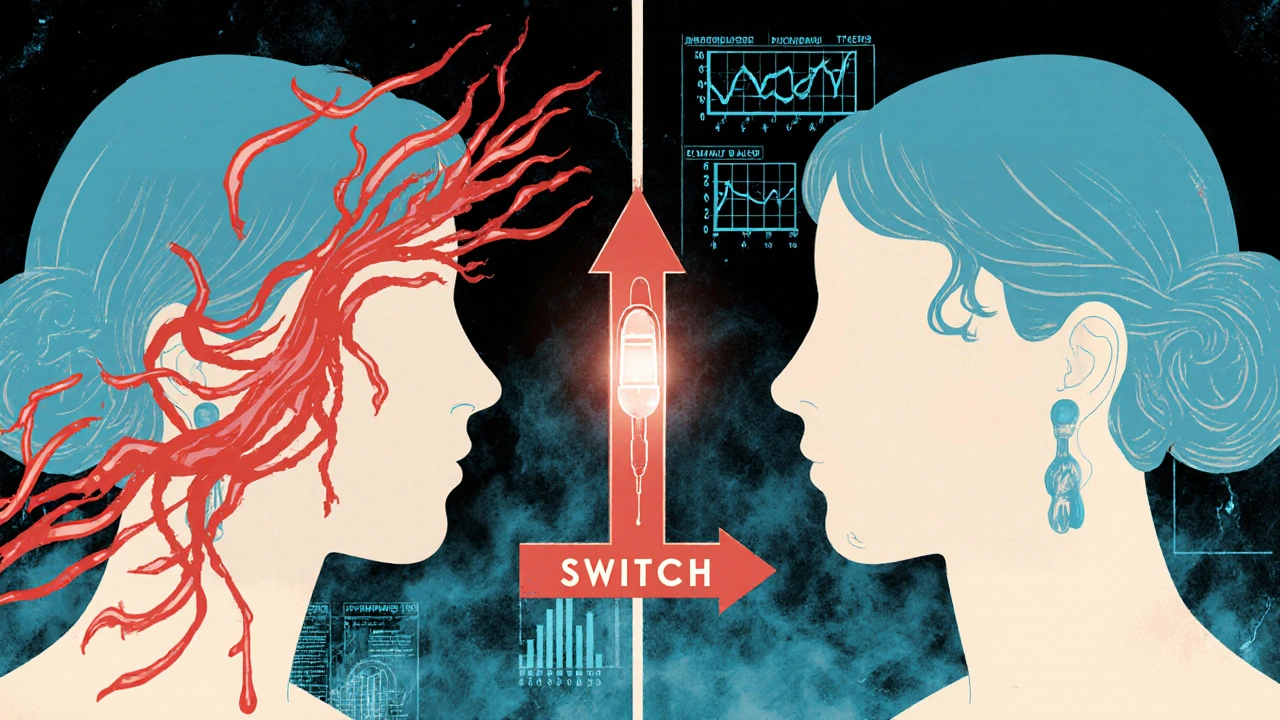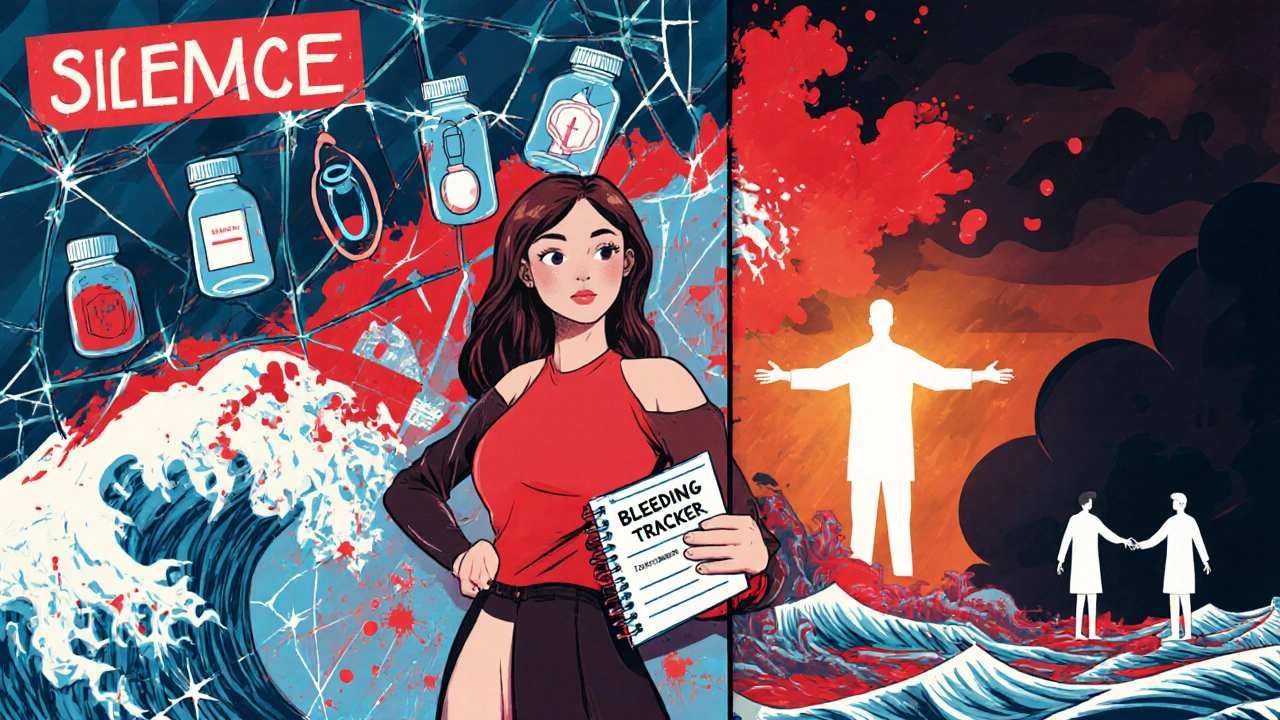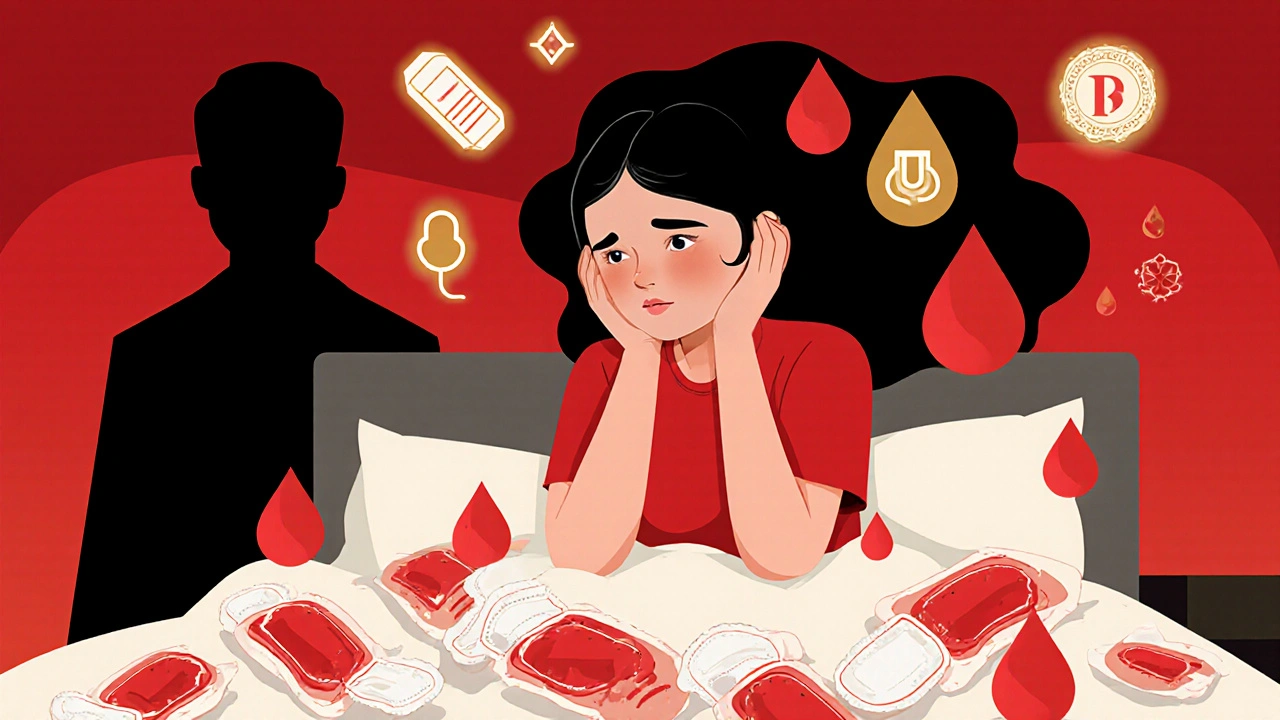Blood Thinner Impact Calculator
How Blood Thinners Affect Your Period
Select the blood thinner you're taking to see its impact on menstrual bleeding and appropriate treatment options.
Your Risk Level
This is your estimated risk of heavy menstrual bleeding while taking this medication.
Recommended Treatment Options
Select your blood thinner to see treatment options.
When you start taking a blood thinner-whether it’s for a blood clot, atrial fibrillation, or another condition-you’re told the big risks: stroke, pulmonary embolism, internal bleeding. But no one talks about your period.
That’s a problem. About 70% of menstruating women on blood thinners experience heavy menstrual bleeding (HMB) that disrupts their lives. It’s not rare. It’s common. And it’s often ignored.
Imagine changing pads or tampons every 30 minutes. Leakage on your clothes. Missing work because you’re afraid to leave the house. Waking up soaked through. That’s not normal. That’s not just "a side effect." It’s a medical issue that needs attention-and it’s treatable.
Why Blood Thinners Make Periods So Heavy
Blood thinners don’t make your uterus bleed more. They just stop your body from stopping the bleeding.
When you have a normal period, your body naturally forms clots to slow down blood flow. Blood thinners like warfarin, rivaroxaban, apixaban, or dabigatran block those clotting factors. So when your uterine lining sheds, the blood keeps flowing-longer and heavier than usual.
Studies show that 66-70% of women on oral anticoagulants develop HMB within the first few months. That’s two out of three. For context, only 10-30% of women without blood thinners have heavy periods. The jump is huge.
And it’s not just about volume. Women report needing to carry emergency changes everywhere. Anxiety spikes. Social life shrinks. Many say they feel like they’re living under a constant threat of public embarrassment.
Which Blood Thinners Are Worst for Heavy Periods?
Not all blood thinners are equal when it comes to menstrual bleeding.
Rivaroxaban carries the highest risk. Women on this drug are more likely to experience severe bleeding than those on other options. Apixaban and dabigatran, on the other hand, show significantly lower rates of heavy periods. Warfarin falls somewhere in between.
This matters because you might not need to stop your blood thinner. You might just need to switch it.
If you’re on rivaroxaban and your periods have become unbearable, talk to your doctor about switching to apixaban. It’s not a guaranteed fix-but for many, the difference is noticeable. One study found that women who switched from rivaroxaban to apixaban saw a drop in bleeding severity within two cycles.
Don’t assume your current drug is your only option. Your clot risk can still be managed with a different anticoagulant that’s gentler on your cycle.
First-Line Treatment: Hormonal Options
The most effective, evidence-backed way to manage heavy bleeding on blood thinners is hormonal therapy. And the good news? You can use these while staying on your blood thinner.
Levonorgestrel IUD (Mirena, Kyleena, etc.) is the gold standard. It releases a low dose of progestin directly into the uterus, thinning the lining and reducing bleeding by 70-90% within 3-6 months. Many women end up with light spotting-or no period at all. One woman on Eliquis told her Reddit thread: “After Mirena, my periods went from ER visits to nearly nonexistent.”
Progestin implants (Nexplanon) work similarly. They’re inserted under the skin and last up to three years. Bleeding often becomes irregular at first, but most women see major improvement after 3-6 months.
Oral progestins like norethisterone (5 mg three times daily for 21 days) are recommended by the American Society of Hematology for acute control. It’s not a long-term solution, but it can stop a heavy bleed fast.
Combined hormonal birth control (pills, patch, ring) is also safe with most anticoagulants. It’s not always the first choice because estrogen can slightly increase clot risk-but for women without other clotting risk factors, it’s a viable option that reduces bleeding by 40-60%.

Tranexamic Acid: The Non-Hormonal Option
If you don’t want hormones, tranexamic acid is your next best bet.
This prescription pill works by helping your blood clot normally during your period. It doesn’t affect your overall clotting system-it just acts locally in the uterus. You take it only during bleeding days: 1-2 tablets every 8 hours for up to 5 days.
Clinical trials show it reduces menstrual blood loss by 30-50%. It’s especially helpful for women who still want to get pregnant, since it doesn’t interfere with ovulation.
Important: Don’t take tranexamic acid with aspirin or NSAIDs like ibuprofen. Those drugs also affect clotting and can increase bleeding risk when combined. Always check with your doctor before mixing.
What About NSAIDs Like Ibuprofen?
Yes, ibuprofen and other NSAIDs can reduce menstrual bleeding by 20-40%. But here’s the catch: they also thin your blood.
Using them alongside anticoagulants adds up. You’re stacking two bleeding risks. For many women, that’s too dangerous. One study found that NSAID use in anticoagulated patients doubled the chance of needing a blood transfusion.
That said, if your bleeding is mild and you’re on a low-risk anticoagulant like apixaban, your doctor might allow occasional low-dose ibuprofen for pain relief. But don’t use it as a primary treatment for heavy bleeding. It’s not safe long-term.
Why Most Women Don’t Get Help
Here’s the ugly truth: most doctors don’t ask.
A National Blood Clot Alliance survey found that 68% of women said their hematologist never asked about their periods after starting anticoagulation. Meanwhile, 72% of those women had bleeding severe enough to disrupt their lives.
It’s not that doctors don’t know. They do. But HMB has been treated as a “women’s issue”-something gynecologists handle. Meanwhile, hematologists focus on preventing clots and assume bleeding is “expected.”
That mindset is changing. The American Society of Hematology and ACOG are releasing joint guidelines in mid-2025 that will require providers to screen for menstrual bleeding at the time anticoagulation starts. But until then, you have to speak up.

What Not to Do
Don’t skip doses. Don’t stop your blood thinner. Don’t wait for it to get better.
Skipping doses to reduce bleeding increases your risk of a life-threatening clot by five times. That’s not worth it. Even if your period is awful, stopping your anticoagulant is far more dangerous.
Don’t try to “tough it out.” Heavy bleeding can lead to iron deficiency anemia-fatigue, dizziness, heart palpitations, hair loss. Many women don’t realize their exhaustion is from blood loss, not stress or sleep deprivation.
Don’t assume surgery is your only option. Endometrial ablation (a procedure that destroys the uterine lining) works for many women-but it’s risky if you’re on blood thinners. It requires stopping anticoagulants, which brings back the fivefold clot risk. Plus, you still need birth control afterward. It’s a last resort.
What You Can Do Right Now
1. Track your bleeding. Use an app or a simple journal. Note how often you change products, if you leak, if you pass clots larger than a quarter. This data helps your doctor.
2. Ask your hematologist: “Have you seen other women on this medication with heavy periods? What’s the best way to manage it without stopping the drug?”
3. Ask your gynecologist: “Can I get a levonorgestrel IUD while on anticoagulants?” The answer is almost always yes.
4. Get your iron checked. Even if you don’t feel anemic, low ferritin (stored iron) is common. A simple blood test can tell you if you need supplements.
5. Don’t accept silence. If your doctor says, “It’s just a side effect,” ask for a referral to a hematologist who specializes in women’s health or a gynecologist with experience in anticoagulation.
The Bigger Picture
There are over half a million women in the U.S. alone on blood thinners who still have periods. And right now, most of them are suffering in silence.
This isn’t just about comfort. It’s about treatment adherence. Studies show 30-50% of young women stop taking their anticoagulants within the first year because of heavy bleeding. That’s not rebellion. That’s survival.
When your period controls your life, you’ll find a way to avoid the medicine that’s causing it-even if that means risking a stroke or a pulmonary embolism.
But you don’t have to choose. You can have both: safety from clots and control over your body.
The tools exist. The evidence is clear. The guidelines are coming. You just need to ask for them.
Can I still get pregnant if I use a hormonal IUD while on blood thinners?
Yes. The levonorgestrel IUD is a highly effective form of birth control and does not interfere with fertility after removal. It’s safe to use with all types of anticoagulants. Many women use it specifically because it reduces bleeding and prevents pregnancy at the same time.
Will switching from rivaroxaban to apixaban stop my heavy periods?
It won’t guarantee an end to heavy bleeding, but studies show it significantly reduces the risk. Many women report lighter periods within 1-2 cycles after switching. It’s one of the safest and most effective adjustments you can make without adding new medications.
Is tranexamic acid safe with warfarin?
Yes, tranexamic acid is generally safe with warfarin. Unlike NSAIDs, it doesn’t affect blood clotting system-wide-it only works in the uterus during your period. But always confirm with your doctor, especially if your INR is unstable.
Can I take iron supplements while on blood thinners?
Absolutely. Iron supplements are safe and often necessary. Heavy bleeding can deplete your iron stores even without full-blown anemia. Take iron on an empty stomach for best absorption, and avoid taking it with calcium or antacids. Vitamin C can help your body absorb it better.
Why don’t doctors talk about this more?
Historically, menstrual bleeding has been dismissed as a "women’s issue" outside the scope of hematology. Many hematologists focus only on preventing clots and assume heavy periods are normal. But new research shows this neglect harms patients. Guidelines are changing, and awareness is growing-but until then, you have to be your own advocate.
